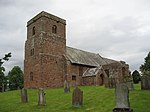Knock, Cumbria
Cumbria geography stubsLong MartonUse British English from September 2019Villages in Cumbria

Knock is a small village in the Eden district of Cumbria, England, and 1.9 km northwest of the larger village of Dufton and 3.1 km south of the village of Milburn. It lies midway between Cross Fell to the north and the town of Appleby-in-Westmorland to the south. Knock is situated 1 km east of the small hamlet and farm, Knock Cross.
Excerpt from the Wikipedia article Knock, Cumbria (License: CC BY-SA 3.0, Authors, Images).Knock, Cumbria
Knock,
Geographical coordinates (GPS) Address Nearby Places Show on map
Geographical coordinates (GPS)
| Latitude | Longitude |
|---|---|
| N 54.637 ° | E -2.496 ° |
Address
Knock
CA16 6DH , Long Marton
England, United Kingdom
Open on Google Maps








